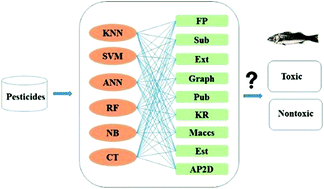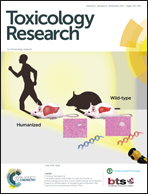In silico prediction of pesticide aquatic toxicity with chemical category approaches†
Abstract
Aquatic toxicity is an important issue in pesticide development. In this study, using nine molecular fingerprints to describe pesticides, binary and ternary classification models were constructed to predict aquatic toxicity of pesticides via six machine learning methods: Naïve Bayes (NB), Artificial Neural Network (ANN), k-Nearest Neighbor (kNN), Classification Tree (CT), Random Forest (RF) and Support Vector Machine (SVM). For the binary models, local models were obtained with 829 pesticides on rainbow trout (RT) and 151 pesticides on lepomis (LP), and global models were constructed on the basis of 1258 diverse pesticides on RT and LP and 278 on other fish species. After analyzing the local binary models, we found that fish species caused influence in terms of accuracy. Considering the data size and predictive range, the 1258 pesticides were also used to build global ternary models. The best local binary models were Maccs_ANN for RT and Maccs_SVM for LP, which exhibited accuracies of 0.90 and 0.90, respectively. For global binary models, the best model was Graph_SVM with an accuracy of 0.89. Accuracy of the best global ternary model Graph_SVM was 0.81, which was a little lower than that of the best global binary model. In addition, several substructural alerts were identified including nitrobenzene, chloroalkene and nitrile, which could significantly correlate with pesticide aquatic toxicity. This study provides a useful tool for an early evaluation of pesticide aquatic toxicity in environmental risk assessment.



 Please wait while we load your content...
Please wait while we load your content...